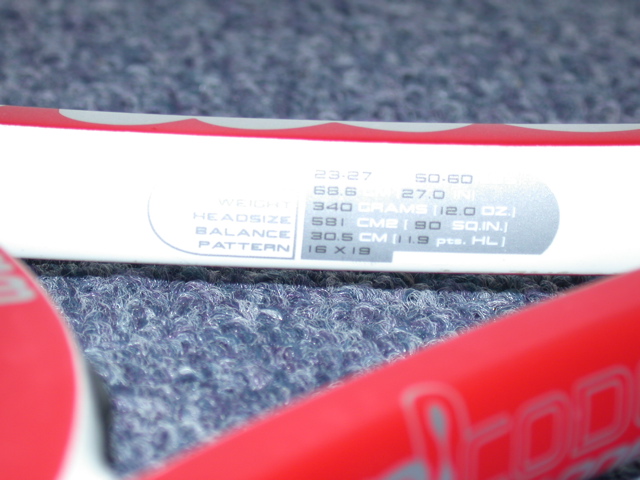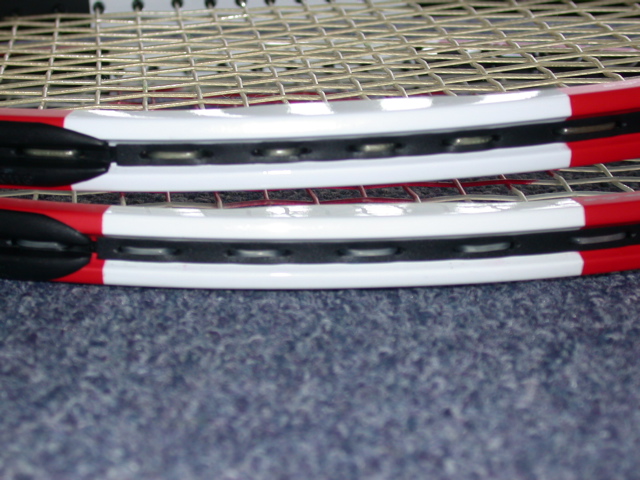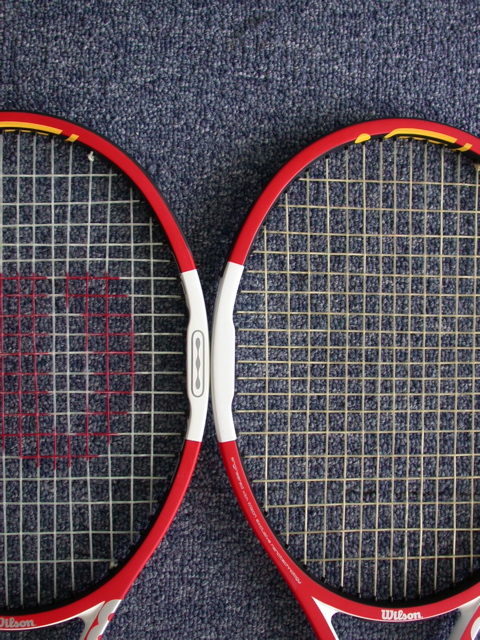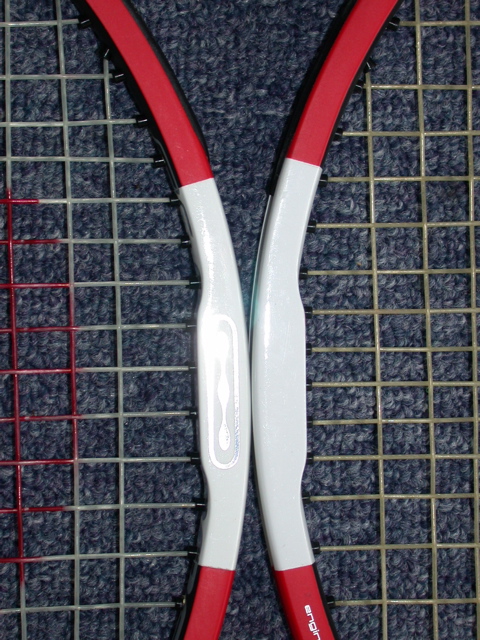Roger Federer’s Wilson nSix-One Tour 90
| Racquet | Mass | Bal. cm | RDC Flex | Swgwt | Length |
|---|---|---|---|---|---|
| Roger’s | 360.5 | 31.6 | 65 | 330 | 27 |
| Retail | 354.0 | 32.0 | 66 | 325 | 27 |
Notes on Roger’s racquet
- The specifications for Roger’s racquet are virtually identical to those for the retail version. Some of the discrepancies shown in the table above can be due to:
- Manufacturing differences from frame to frame;
- I measured the retail version as-is; I measured Roger’s racquet with an overgrip. (The overgrip adds about 4 grams to the total mass, and lowers the balance point.)
- The head size on Roger’s racquet appears to be identical to that of the retail version. I don’t have a super-accurate method of measuring head size, but whatever the head size on the retail Wilson nSix-One Tour 90, that’s the head size on Roger’s racquet. Roger’s racquet is also the same length (27 inches) as the retail version.
- The beam width of Roger’s racquet (measured midway up the shaft) is identical to that of the retail version, at 17.5 mm.
- There is no reason to believe that Roger’s racquet is anything but a Wilson nSix-One Tour 90, which has been modified to Roger’s individual wishes by the Wilson Pro Room.
- My understanding is that Wilson designed this racquet for Federer. I find it very difficult to believe the claims made by some that Wilson purposely designed a racquet that was not right, so it would then have to modify the racquet to be right for Federer. It seems logical to me that Wilson would have designed the racquet to be as close as possible to what Federer wanted. This would save Wilson time and aggravation.
- I likewise don’t believe that Federer takes his custom-designed racquet to Priority One for anything but stringing (and perhaps a tiny bit of fine-tuning). The racquet designers at Wilson are pretty sharp cookies — I deal with them from time to time. I find it difficult to believe that they were aiming to design a racquet to Federer’s specifications, but they missed, so Priority One has to save the day. It just doesn’t make sense. To me, the simplest explanation is the best.
- I should point out that Wilson has provided USRSA with other players’ frames over the years, and in each case I can remember, it provided what appeared to be the actual frame, not the retail version of that frame, even when the player’s frame was way different than the retail frame it appeared to be. I find it difficult to believe that in this one case, Wilson would supply USRSA with some mutant version of a player’s frame.
- Roger’s racquet is different from the retail version in some ways. Among these are:
- The
pallet
(the portion of the racquet where you hold the racquet during play) is shorter on Roger’s racquet. This could be because the earlier Wilson racquets Roger used had shorter pallets, or it could be because Roger used to use a shorter overgrip such as the Unique Tourna Grip, which necessitated a shorter pallet (he now uses the Wilson Pro Overgrip). - The spacing of the cross strings is more even on Roger’s racquet. On the retail versions, Wilson uses differential spacing on the crosses, which make the playing characteristics more predictable. This spacing difference is most easily seen in the
PWS
sections at 3 and 9 o’clock on the hoop, wherein there are only four cross strings on Roger’s racquet, while there are five on the retail version. - The sections of red and white graphics on the hoop are slightly different on Roger’s racquet, to match the different spacing of the crosses.
- The bumperguard and grommet strip on Roger’s racquet are slightly different on Roger’s racquet, to accommodate the different spacing on the crosses.
- For confirmation of the visual differences between Roger’s racquet and the retail version, see my series of photos comparing the two. In these photos, Roger’s racquet has the
W
stencil on the string. USRSA received this racquet directly from Wilson for use at the U.S. Open Kids’ Day program. The strings are not those used by Roger, as those were install by USRSA.
- The
- I also conducted a playtest of this racquet.






The head size controversy
There are some who claim that Roger uses a racquet with an 88-square-inch head size, as opposed to a 90-square-inch head size. The implication is that the retail version is actually 90 square inches, but that Wilson has completely separate molds for Roger’s racquets, so that his racquets are a bit smaller than the racquets the average consumer can buy.
I therefore also attempted to measure the head size of Roger’s racquet. My procedure was to get a digital image of the racquet, use image analysis to determine the number of pixels inside the hoop, and convert this to square inches.
To get a digital image, I both scanned the racquet at 300 dpi and photographed it with a digital camera. I then processed each image with Adobe Photoshop to erase
all pixels within the hoop, and then analyzed each image with ImageJ.
I ran into two difficulties: First, for some reason the X and Y dimensions in the digital images did not have the same mapping to actual measurements of the racquet. Second, it is extremely difficult to be precise when erasing unwanted background from the inside of the hoop. Therefore, there may be some error in my calculations. I toyed with the idea of mounting and lighting the racquet in such a way that the digital camera image would be easier to manipulate, however, this would still leave the parallax error. If I get excited about this project again in the future, I will mount and light the racquet differently, and use my 600 mm telephoto lens to mitigate the parallax error.
My calculations based on the digital scan of the racquet gave the result of 88.46 square inches. My calculations based on the digital camera image of the racquet gave the result of 86.7 square inches. Based on these results, it seems that Roger’s racquet does indeed have a head size of 88 square inches.
However, I also evaluated the hoop size of a retail K Six.One Tour 90, and came out with almost identical results. Based on these results, it seems that there is no difference in the mold used to make the retail versions of the Federer
racquet.
Just so that everyone understands how little difference there is between these racquets, I refer you to the image below, which I generated using Adobe Illustrator.

Although this hoop shape is idealized, you can see that there is very little difference among these four head sizes, with an especially small difference between the 88- and 90-square-inch head sizes.